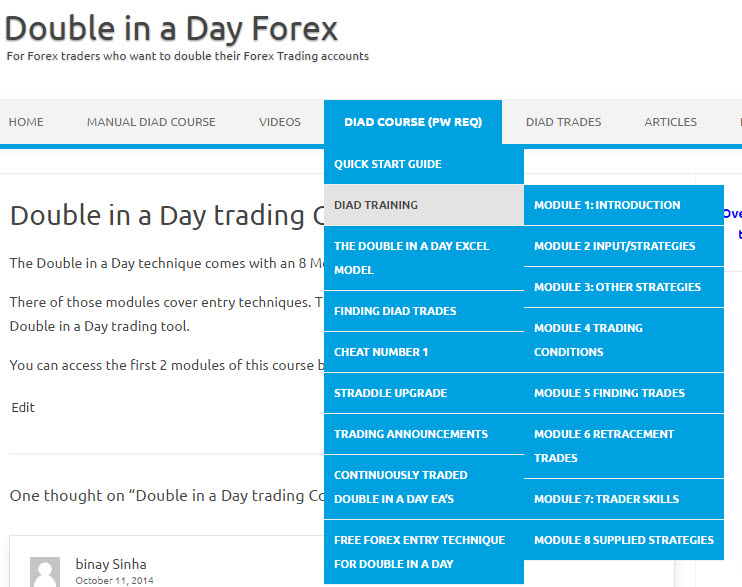Double in a Day trading Course
The Double in a Day technique comes with an 8 Module trading course .
You can access the training material using the training menu options and your DIAD website password.
Three of those modules cover entry techniques. The others help you achieve the most out of using the Double in a Day trading tool.
You can access the first 2 modules of this course by applying using the facility on the righthand side
How To Become A Successful Forex Trader
Retail traders just starting out in the forex market are often unprepared for what lies ahead and, as such, end up undergoing the same life cycle: first they dive in head first – usually losing their first account – and then they either give up, or they take a step back and do a little more research and open a demo account to practice. Those who do this will often eventually open another live account, and experience a little more success – breaking even or turning a profit. To help avoid the losses from hastily diving into forex trading, this article will introduce you to a framework for a medium-term forex trading system to get you started on the right foot, help you save money and ultimately become a profitable retail forex trader. (For background reading, check out Top 4 Things Successful Forex Traders Do.)
Introduction To The Forex Market
Why Medium Term?
So, why are we focusing on medium-term forex trading? Why not long-term or short-term strategies? To answer that question, let’s take a look at the following comparison table:
Type of Trader Definition Good Points Bad Points
Short-Term (Scalper) A trader who looks to open and close a trade within minutes, often taking advantage of small price movements with a large amount of leverage. Quick realization of profits or losses due to the rapid-fire nature of this type of trading. Large capital and/or risk requirements due to the large amount of leverage needed to profit from such small movements.
Medium-Term A trader typically looking to hold positions for one or more days, often taking advantage of opportunistic technical situations. Lowest capital requirements of the three because leverage is necessary only to boost profits. Fewer opportunities because these types of trades are more difficult to find and execute.
Long-Term A trader looking to hold positions for months or years, often basing decisions on long-term fundamental factors. More reliable long-run profits because this depends on reliable fundamental factors. Large capital requirements to cover volatile movements against any open position.
Now, you will notice that both short-term and long-term traders require a large amount of capital – the first type needs it to generate enough leverage, and the other to cover volatility. Although these two types of traders exist in the marketplace, they are often positions held by high-net-worth individuals or larger funds. For these reasons, retail traders are most likely to succeed using a medium-term strategy.
The Basic Framework
The framework of the strategy covered in this article will focus on one central concept: trading with the odds. To do this, we will look at a variety of techniques in multiple time frames to determine whether a given trade is worth taking. Keep in mind, however, that this is not a mechanical/automatic trading system; rather, it is a system by which you will receive technical input and make a decision based upon it. The key is finding situations where all (or most) of the technical signals point in the same direction. These high-probability trading situations will, in turn, generally be profitable. Chart Creation and Markup
Selecting a Trading Program
We will be using a free program called MetaTrader to illustrate this trading strategy; however, many other similar programs can also be used that will yield the same results. (For more tips on how to find one, see Forex Automation Software For Hands-Free Trading.) There are two basic things the trading program must have:
the ability to display three different time frames simultaneously
the ability to plot technical indicators, such as moving averages (EMA and SMA), relative strength index (RSI), stochastics and moving average convergence divergence (MACD)
Setting up the Indicators
Now we will look at how to set up this strategy in your chosen trading program. We will also define a collection of technical indicators with rules associated with them. These technical indicators are used as a filter for your trades.
……………………..
For more information please use this link:- http://www.investopedia.com/articles/forex/05/060205.asp
